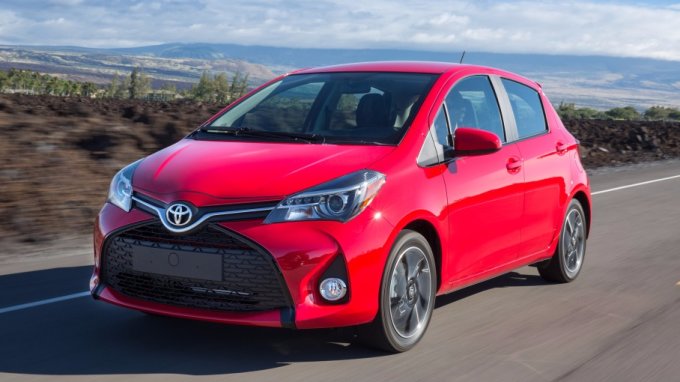 The 2017 Toyota Yaris comes with standard Toyota Safety Sense C (TSS-C) ADAS and smartphone connectivity. The Yaris is one of thefew sub-compact/minicar models that comes with the advanced safety features as standard. IIHS has not rated the 2017 model, yet.
The 2017 Toyota Yaris comes with standard Toyota Safety Sense C (TSS-C) ADAS and smartphone connectivity. The Yaris is one of thefew sub-compact/minicar models that comes with the advanced safety features as standard. IIHS has not rated the 2017 model, yet.
Toyota Safety Sense C is designed to help address three key areas of driver assistance: preventing or mitigating frontal collisions, helping keep drivers within their lane, and to help enhance road safety during nighttime driving. Technologies include Toyota’s Pre-Collision System, Lane Departure Alert and Automatic High Beams. Yaris is the first entry subcompact in the segment to standardize these key safety features across all grades.The instrument gauge cluster looks sporty and offers lots of functionality. Below the large speedometer, an LCD multi-information display includes functions for odometer, trip meter, clock, outside temperature, fuel economy and average speed. Plenty of storage compartments, including numerous small pockets around the driver’s seat, can keep digital devices and other personal items out of sight.
In all Yaris models, the standard Entune Audio system includes a 6.1-inch touch screen, an AM/FM CD player with MP3/WMA playback capability, six speakers, HD Radio with iTunes Tagging, auxiliary audio jack, USB port with iPod® onnectivity and control, hands-free phone capability, voice recognition, and music streaming via Bluetooth wireless technology. A navigation system is an available port- or dealer-installed option
The Yaris three- and five-door models come in L and LE grades, and five-door also offers the sporty SE grade. The mono-spec trims eliminate option packages, and in the Toyota tradition, standard equipment is comprehensive. The Yaris L starts with air conditioning, sport-tuned electric power steering, three-spoke tilt steering wheel, power door locks with illuminated entry, cargo area cover and lamp, power windows with driver’s side auto up/down, and color-keyed folding outside mirrors. The LE adds the convenience of power mirrors, cruise control, steering wheel audio controls and a remote keyless entry system with engine immobilizer..
Also in the Toyota tradition, the 2017 Yaris features details that the owner appreciates more and more as the years go by. Take the wide-sweeping single windshield wiper design, for example. Its innovative wet-arm washer system sprays washer fluid from the base of the wiper arm directly into the blade’s path for improved cleaning. And, all Yaris models come standard with a rear window wiper. There’s even a feature that automatically turns off any interior lights after 20 minutes if the ignition is switched off to help prevent a dead battery.
Big Safety, and Nine Airbags
Protection in a collision in the 2017 Yaris starts with an impact-absorbing body structure that makes wide use of high-tensile strength steel to help absorb and distribute collision forces. All Yaris models come equipped with nine SRS airbags, including:
- Driver and front-passenger dual-stage airbags
- Driver and front-passenger seat side airbags
- Front-passenger seat cushion airbag
- Side curtain shield airbags
- Driver’s knee airbag
The Advanced Whiplash Injury-Lessening (WIL) front-seat structure helps to ensure that the region from the head to the lower back is supported, helping to reduce whiplash-type injuries during certain types of rear end collisions.
Like all Toyota vehicles, the 2017 Yaris features the Star Safety System, which includes:
- Vehicle Stability Control (VSC)
- Traction Control (TRAC)
- Anti-lock Braking System (ABS)
- Electronic Brake-Force Distribution (EBD) and Brake Assist
- Smart Stop Technology (Toyota’s brake-override system)
Toyota Safety Sense-C (TSS-C)
The Toyota Safety Sense-C system, standard in the 2017 Yaris, combines a trio of advanced safety technologies.
Pre-collision System (PCS), which operates at vehicle speeds of approximately 7 to 85 mph, is designed to detect a vehicle ahead using a camera and laser beam. If PCS determines there is a possibility of a collision, it uses audio and visual alerts to prompt the driver to take evasive action and brake.
If the driver notices the hazard and applies the brakes, PCS may provide additional braking force using Brake Assist. If the driver does not brake in a set time, and PCS determines that the possibility of a frontal collision with another vehicle is extremely high, the system may automatically apply the brakes, reducing speed by up to 19 mph under certain conditions to help the driver reduce the impact and in certain cases avoid a collision.
Lane Departure Alert (LDA) is designed to use a camera to detect visible white and yellow lane markings in front of the vehicle and the vehicle’s position on the road. If LDA determines that the vehicle is starting to unintentionally deviate from its lane, the system alerts the driver with an audio and visual alert.
Automatic High Beam (AHB), at speeds above approximately 25 mph, is designed to use an in-vehicle camera to help detect the headlights of oncoming vehicles and taillights of vehicles traveling ahead, automatically switching between high and low beams as appropriate.